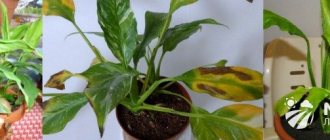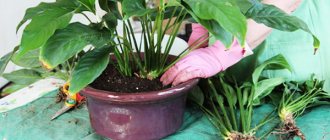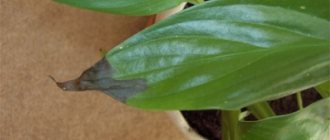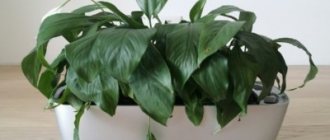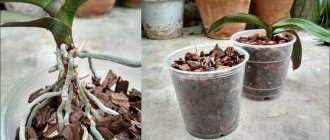Is this normal?
Experienced plant growers are aware that the spathiphyllum flower has a spathe, also called a bract, whose bright “feminine happiness” color attracts insects for pollination.
The color of the bedspread can be different: from pale it gradually turns into greenish, sometimes this color can be too saturated. Many people are interested in why spathiphyllum produces green flowers. This color change is alarming. There is nothing wrong with greening of inflorescences, since this is a normal process, but sometimes this can also happen due to a disease. It is important to understand the reasons in time.
Why does the Spathiphyllum flower have green instead of white flowers? Ways to solve the problem
Spathiphyllum is a very common indoor plant loved by gardeners. Many people enjoy growing it, because the flower does not require special care skills. The plant pleases its owners with its exquisite and original inflorescences, and in general, it is an unpretentious plant, however, if you do not follow the recommendations, difficulties may arise.
There is a sign that a gift of spathiphyllum brings happiness to the personal lives of girls and women; it is popularly called “women’s happiness.” The goddess of love, Astarte, breathed into the flower a piece of the happiness that she experienced on her wedding day. According to legend, it will bring happiness to those who believe in its power. In the article we will look at what to do if the flower called Women's Happiness has green flowers.
When is greening caused by disease and when is it natural?
- Natural reasons include the age of the spathiphyllum: the older it is, the less chance it has of pollination, and then the bract begins to turn green, merging with the rest of the foliage, because it no longer needs to attract insects.
If, for aesthetic reasons, you do not want the bedspreads to be green, then you can carefully cut them off with scissors. This is also done to rejuvenate the plant. It will be easier for new inflorescences to appear (read about how often spathiphyllum blooms at home, when this process begins and how to help the plant). - Sometimes greening of spathiphyllum bedspreads can be a sign of a lack or excess of fertilizer. This phenomenon is called chlorosis. After the bedspreads turn green, brown-yellow formations begin to appear.
- Also, prolonged exposure to direct sunlight can cause not only burns on the leaves, but also greening of the plant inflorescences. It is important to move the container with spathiphyllum in time to a place with softer light and low temperature.
- The fact that “female happiness” blooms green can equally be caused by both systematic flooding and, conversely, low humidity levels.
The disease is not the cause, but the consequence of this phenomenon. For example, if the soil is constantly waterlogged, then a fungal disease will soon appear, and green covers will only be its manifestation. This fungal attack, called late blight, primarily affects the neck of the root. Fungicidal drugs will help cope with it.
“Women's happiness” pleases the soul and the eye, but only if it is healthy and blooms. Read about what to do if there is no flowering and why there are no buds on our website.
Spathiphyllum diseases: photos and descriptions
Considered a low-maintenance plant that can be easily grown at home, spathiphyllum can still suffer from improper handling and diseases caused by fungi and bacteria.
Most often, systemic waterlogging of the soil, lack of light and excessive dry air lead to weakening of the plant and the development of spathiphyllum diseases.
Diseases manifest themselves as:
- yellowing or blackening of foliage;
- refusal of bushes to throw out flower stalks;
- growth arrest;
- even the death of spathiphyllum, if the most decisive measures are not taken in time.
The first traces of spathiphyllum disease become visible on the leaves, which change color and dry out, then the inflorescences turn black and wither, but the main picture is often found underground, where harmful fungi cause devastating damage to the root system, stems and base of the petioles.
Root rot on spathiphyllum
Cylindrocladium spathiphylli or root rot on spathiphyllums, caused by fungi dangerous to the plant, most often occurs in warm, humid times. The spread is promoted not only by soil moisture, but also by its low acidity.
Under the influence of spathiphyllum disease, as in the photo, the lower leaves become lethargic and discolored. But these are only obvious symptoms. The main development of the disease occurs under the soil and affects the root system. Reddish-brown spots appear on the roots, coinciding with tissue damage.
The affected areas quickly grow, rot and lose functionality, and thousands of fungal spores remain in the soil, and when they get on the leaves and other above-ground parts of the plant, round brown spots appear, surrounded by yellowed tissue.
Spores are transported by drops of water, so spathiphyllums should not be placed close to each other or in contact with water from adjacent pots. Diseased plants are isolated, measures are taken to drain the soil and treated with fungicides. As a preventative measure, a watering regime is established.
Rotting of the base of the stem, petioles and roots can also be caused by other harmful fungi, Rhizoctonia solani and Sclerotium rolfsii, living in the soil. At the border with the soil, plant tissues become covered with brown spots, which become wet and flake. On leaf blades and petioles, the spots first have a yellow tint, and then darken and undergo necrosis. Spathiphyllums infected with this disease, especially at a young age, often die and must be removed.
Having noticed alarming symptoms of root rot, you should not limit yourself to pruning the affected foliage and externally examining the plant. It is important to make sure that the root system is viable, the roots are dense, white and can supply the spathiphyllum with moisture and nutrients.
- For those affected, as in the photo, the roots are removed from spathiphyllum disease.
- The remaining parts are sprinkled with crushed charcoal.
- Then, the plant treated with fungicide is transplanted into new, disinfected soil.
Late blight on the base of the spathiphyllum stem
The harmful fungus Phytophthora is the cause of root rot and leaf spot. The spores of the causative agent of spathiphyllum disease are found in the soil and, when high humidity is maintained, they easily spread to the above-ground part of the flower, and also begin to act underground. The first signs of the disease can be seen on the root collar of the plant, which darkens and becomes wet.
In spathiphyllum plants, as a result of the disease, as in the photo, leaves develop chlorosis, wilting and necrosis. The roots, as with other types of rot, soften and die.
Infection is possible both through tools and through splashes of moisture during watering. To reduce the risk of developing the disease, it is necessary to prevent stagnation of moisture in the pots and arrange watering so that the top layer of soil dries out in the intervals.
Sick specimens of spathiphyllum will have to be destroyed, and the remaining plants and related species in the neighborhood must be treated with special preparations.
Chlorosis and swelling of spathiphyllum leaves
Systematic violation of the spathiphyllum conditions can result in the development of diseases such as leaf chlorosis and swelling.
The reasons here are:
- high humidity of the air and soil environment, provided that the room temperature is lower than usual;
- irregular or unbalanced feeding;
- damage to the root system caused by transplantation or infection.
The condition when the foliage is covered with yellowish-brown convex and constantly growing spots is very painful for spathiphyllum and can lead to the death of the plant.
In order for the bush to regain its former appearance and attractiveness, it is necessary to organize care, including fertilizing and watering the flower.
Spathiphyllum gommosis
Bacterial leaf wilt, caused by Xanthomonas dieffenbachiae and common not only on spathiphyllum but also on related plant species, develops on the edges of infected leaves. The leaf blades gradually darken, the tissues dry out and die. Spathiphyllum disease, as in the photo, can cause serious damage, because by losing foliage, the bush loses some of its strength and nutrition.
The pathogen is carried by drops of water, and spathiphyllums are most at risk if members of the family such as Dieffenbachia, anthuriums or callas are grown nearby.
Spathiphyllum affected by sooty fungus
If plants are attacked by pests, such as aphids, scale insects or mealybugs, the sticky stalk secreted by the insects becomes a site for the development of sooty fungus. This disease does not cause serious direct harm to spathiphyllum, but the black coating covering the leaf blades negatively affects the process of photosynthesis, and the plants quickly weaken.
Treatment consists of treating the foliage and petioles with a soap solution, as well as treating the spathiphyllum with an insecticide that kills insects.
How to prevent the appearance of unusual plant colors?
Accordingly, in order for the bracts not to turn green during the life of the plant, it is necessary to solve the problems listed above, gradually eliminating each one.
Content Rules
- Move the spathiphyllum to an eastern or western windowsill if it turns green during the growing season. If this happens in winter, then excessive illumination can be excluded from the list.
- In winter, keep the plant as far as possible from heating devices and spray it daily, thereby ensuring a sufficient level of humidity. During the growing season, spray as often as possible and do not keep in drafts.
- Constantly maintain a certain temperature in the room with spathiphyllum - 18 - 25 degrees (depending on the time of year).
- Establish a feeding regime, fertilize in doses, in small quantities.
Preventing re-discoloration
Despite all the above reasons for this phenomenon, the most basic is the natural aging of spathiphyllum, and not disease, abnormal conditions or fungus.
- To ensure that the plant always has only white inflorescences, the green ones can be carefully cut off.
- Water the flower only when the top layer of the substrate dries and fertilize no more than once a week.
- And, of course, the right temperature, lighting and humidity.
It is impossible to do without the basic conditions for keeping spathiphyllum, and all prevention consists of maintaining comfortable conditions for the plant.
It is important to know that in some cases, even under ideal conditions for growing spathiphyllum, its inflorescences may turn green. This may be the end of flowering, or the aging process. This is an absolutely normal phenomenon and there is no need to be afraid of it.
“Come on, let’s get treatment”: our actions
- Cut off the green flower along with the petiole. This will encourage the plant to grow new flower stalks.
- First of all, review the light mode of the flower. When moving the pot to another window sill, remember: the room should be well ventilated, spathiphyllum needs clean air. But there should be no drafts!
- Remember what soil you planted the flower in. Women's happiness does not like acidic soil. Choose only slightly acidic substrates. And if you haven’t replanted a spatik yet (you just bought it or received it as a gift), buy special soil and replant the bush, even if it’s not spring yet. The soil in which the plant brought from the store grows is definitely poor, and is also probably stuffed with all sorts of chemicals that cause increased flowering of this crop. Remove spathiphyllum from this “fast food” into normal nutrient soil.
- Feed the flower. In winter, spatika can be given food once every 4 weeks, in other seasons - every 2 weeks, but it can be more often (weekly), it all depends on the specific food you purchased. If you love to tinker with flowers, buy organic fertilizer, and if you constantly lack time or are forgetful, take mineral fertilizer - as a rule, these are the products that are given to the flower no more than twice a month.
- Remember how often you water the flower. Perhaps the problem with flowers arose due to the fact that spathiphyllum constantly grows in a dry substrate. This is probably true if you have repeatedly noticed that the leaves of your flower wither and droop along with the petioles, and after watering they rise again.
By the way, while talking on forums about the vagaries of my spathiphyllum, I heard the following opinion: why do anything with green flowers if the bush itself looks healthy? Grass-colored flowers are also beautiful. Moreover, many people have white spathiphyllums, but you still need to look for green ones, so you shouldn’t do anything about this phenomenon...
What do you think about this worldview?
